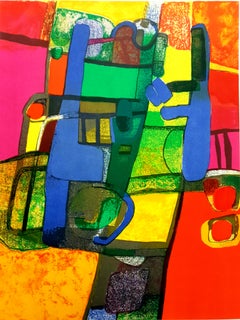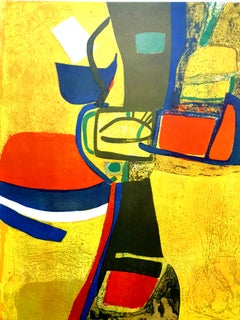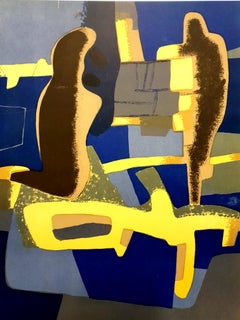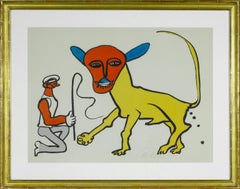Maurice Estève Animal Prints
French, 1904-2001
Maurice Estève was born May 2, 1904 in Culan in the Cher where he spent his childhood with his grandparents. He joined them in 1913 in Paris, where he discovered the Louvre Museum (he is particularly impressed by the Battle of San Romano by Paolo Ucello). Returning to Culan for the summer, he stayed there during the war years, began painting as early as 1915. He lived in Paris again from 1918. Apprentice to a typographer then to a modern furniture design studio, he followed Drawing evening class, discovers in 1919 the painting of Cézanne.
Back in Paris he attended Montparnasse the free workshop of the Academy Colarossi. Marked until then by the painting of the Primitives and the work of Cézanne, it passed temporarily in 1927 the influence of surrealism, including Giorgio de Chirico. He presents his first solo exhibition in 1930 before becoming interested in film and directing. On the advice of Braque who participates, he is asked in 1936 to exhibit in Stockholm with Matisse, Picasso, Juan Gris and Fernand Léger. He participated the following year in the realization of the wall decorations of Robert and Sonia Delaunay for the pavilions of the Aviation and Railways at the Universal Exhibition of Paris.
Estève, who works regularly during the summer in Culan, makes lithographs, regularly practices watercolor but also charcoal, monotype, collage. In 1970, he received the Grand Prix National des Arts. From 1981 are organized several retrospectives of his work. The City of Bourges decided to present all the works (more than a hundred) which the painter donated to him in 1985 in the Hotel des Echevins, restored with the assistance of the Historic Monuments and the Direction of the Museums of France to become the "Estève Museum", inaugurated in 1987.
Estève moved permanently to Culan in 1995. He died on June 27, 2001.to
3
Overall Width
to
Overall Height
to
3
46
194
161
118
99
3
3
3
3
3
2
2
2
1
3
3
Artist: Maurice Estève
Maurice Estève - Composition - Original Lithograph
By Maurice Estève
Located in Collonge Bellerive, Geneve, CH
Maurice Estève - Composition - Original Lithograph
Colorful Abstraction
1969
From the art review XXe Siecle
Dimensions: 32 x 24 inches
Edition: G. di Sa...
Category
1960s Modern Maurice Estève Animal Prints
Materials
Lithograph
Maurice Estève - Composition - Original Lithograph
By Maurice Estève
Located in Collonge Bellerive, Geneve, CH
Maurice Estève - Composition - Original Lithograph
Colorful Abstraction
1965
From the art review XXe Siecle
Dimensions: 32 x 24 inches
Edition: G. di Sa...
Category
1960s Modern Maurice Estève Animal Prints
Materials
Lithograph
Maurice Estève - Composition - Original Lithograph
By Maurice Estève
Located in Collonge Bellerive, Geneve, CH
Maurice Estève - Composition - Original Lithograph
Colorful Abstraction
1969
From the art review XXe Siecle
Dimensions: 32 x 24 inches
Edition: G. di Sa...
Category
1960s Modern Maurice Estève Animal Prints
Materials
Lithograph
Related Items
Au Repos
By Graciela Rodo Boulanger
Located in San Francisco, CA
This artwork titled "Au Repos (At Rest)" 1983 is an original color lithograph on paper by noted Bolivian artist Graciela Rodo Boulanger, b.1935. It is hand signed and numbered 157/20...
Category
Late 20th Century Modern Maurice Estève Animal Prints
Materials
Lithograph
"Lion Tamer" framed signed lithograph by Alexander Calder. Edition EA of 100.
By Alexander Calder
Located in Boca Raton, FL
"Lion Tamer" lithograph by Alexander Calder. Hand-lettered EA in lower left front corner. Hand-signed Calder in lower right front corner. From an ed...
Category
1970s Modern Maurice Estève Animal Prints
Materials
Lithograph
$12,000
H 31 in W 39.25 in
Beastie, Flying Colors for Braniff Airlines, Lithograph by Alexander Calder
By Alexander Calder
Located in Long Island City, NY
Artist: Alexander Calder (after), American (1898 - 1976)
Title: Beastie, Flying Colors for Braniff Airlines
Year: 1974
Medium: Lithograph, signed in the plate
Size: 20 in. x 26 in. (...
Category
1970s Modern Maurice Estève Animal Prints
Materials
Lithograph
$1,125 Sale Price
25% Off
H 20 in W 26 in
Original 1919, Give the World The Once Over in the United States Navy poster
Located in Spokane, WA
Original 1919 Give The World The Once Over in the United States Navy vintage poster. Archival linen backed. This poster presents itself very fine condition. The lower text por...
Category
1910s American Modern Maurice Estève Animal Prints
Materials
Lithograph
$2,998
H 42 in W 28.5 in D 0.05 in
Modern Israeli Lithograph Reuven Rubin Views Of Israel Judaica Horses, Riders
By Reuven Rubin
Located in Surfside, FL
Lithograph printed by Chez Daniel Jacomet, Paris, France 1960 offset lithograph in colors on Arches, signed in crayon on the justification sheet (this auction is just for the one lithograph pictured as the 1st photo, the justification sheet with the original drawing is just included for provenance and is not part of this sale), on Arches deckle edged paper. limited edition of 250. plate signed and hand signed in pencil.
Israeli views Lithograph by Israeli Master.
Reuven Rubin 1893 -1974 was a Romanian-born Israeli painter and Israel's first ambassador to Romania.
Rubin Zelicovici (later Reuven Rubin) was born in Gala?i to a poor Romanian Jewish Hasidic family. He was the eighth of 13 children. In 1912, he left for Ottoman-ruled Palestine to study art at Bezalel Academy of Art and Design in Jerusalem. Finding himself at odds with the artistic views of the Academy's teachers, he left for Paris, France, in 1913 to pursue his studies at the École Nationale Supérieure des Beaux-Arts. At the outbreak of World War I, he was returned to Romania, where he spent the war years.
In 1921, he traveled to the United States with his friend and fellow artist, Arthur Kolnik, with whom he had shared a studio in Cernovitzu. In New York City, the two met artist Alfred Stieglitz, who was instrumental in organizing their first American show at the Anderson Gallery.Following the exhibition, in 1922, they both returned to Europe. In 1923, Rubin emigrated to Mandate Palestine.
Rubin met his wife, Esther, in 1928, aboard a passenger ship to Palestine on his return from a show in New York. She was a Bronx girl who had won a trip to Palestine in a Young Judea competition. He died in 1974
Artistic career
Joseph Zaritsky...
Category
1960s Modern Maurice Estève Animal Prints
Materials
Lithograph, Offset
Alexander Calder Circus Reproduction Lithograph After a Drawing
By (after) Alexander Calder
Located in Surfside, FL
(after) Alexander Calder
"Calder's Circus" offset lithograph on wove paper after drawings by the artist
Published by Art in America and Perls gallery in 1964 (from drawings done in the 1930's)
these range slightly in size but they are all about 13 X 17 inches (with minor variations in size as issued.) These have never been framed. The outer folio is not included just the one lithograph.
James Sweeny from the introduction “The fame of Calder’s circus spread quickly between the years 1927 and 1930. All the Paris art world came to know it. It brought him his first great personal success. But what was more important, the circus also provided the first steps in Calder’s development as an original sculptor”
Clive Gray wrote ”A visit to the studio of Alexander Calder led to the chance discovery of some hundred masterful circus drawings completed over thirty years ago. We publish, for the first time, a choice of sixteen from that group.” With signed introduction by Miro.
These whimsical drawings, done in the style of wire sculpture, include acrobats, clowns, jugglers, trapeeze artists, an elephant, dog and lion. they are great.
Alexander Calder is widely considered to be one of the most important American sculptors of the 20th century. He is best known for his colorful, whimsical abstract public sculptures and his innovative mobiles, kinetic sculptures powered by motors or air currents, which embraced chance in their aesthetic. Born into a family of accomplished artists, Calder's work first gained attention in Paris in the 1930s and was soon championed by the Museum of Modern Art in New York, resulting in a retrospective exhibition in 1943. Major retrospectives were also held at the Solomon R. Guggenheim Museum (1964) and the Museum of Contemporary Art, Chicago (1974). Calder’s work is in many permanent collections, most notably in the Whitney Museum of American Art, but also the Guggenheim Museum; the Museum of Modern Art; the National Gallery of Art, Washington, D.C.; and the Centre Georges Pompidou. He produced many large public works, including .125 (at JFK Airport, 1957), Pittsburgh (Carnegie International prize winner 1958, Pittsburgh International Airport) Spirale (UNESCO in Paris, 1958), Flamingo and Universe (both in Chicago, 1974), and Mountains and Clouds (Hart Senate Office Building, Washington, D.C., 1976). Although primarily known for his sculpture, Calder was a prodigious artist with a restless creative spirit, whose diverse practice included painting and printmaking, miniatures (such as his famous Cirque Calder), children’s book illustrations, theater set design, jewelry design, tapestry and rug works, and political posters. Calder was honored by the US Postal Service with a set of five 32-cent stamps in 1998, and received the Presidential Medal of Freedom, posthumously in 1977, after refusing to receive it from Gerald Ford one year earlier in protest of the Vietnam War.
Calder moved to New York and enrolled at the Art Students League, studying briefly with Thomas Hart Benton, George Luks, Kenneth Hayes Miller, and John Sloan. While a student, he worked for the National Police Gazette where, in 1925, one of his assignments was sketching the Ringling Bros. and Barnum & Bailey Circus. Calder became fascinated with the action of the circus, a theme that would reappear in his later work.
In 1926, Calder moved to Paris, enrolled in the Académie de la Grande Chaumière, and established a studio at 22 rue Daguerre in the Montparnasse Quarter. In June 1929, while traveling by boat from Paris to New York, Calder met his future wife, Louisa James (1905-1996), grandniece of author Henry James and philosopher William James. They married in 1931. While in Paris, Calder met and became friends with a number of avant-garde artists, including Fernand Léger, Jean Arp, and Marcel Duchamp. Cirque Calder (on view at the Whitney Museum of American Art at present) became popular with the Parisian avant-garde. He also invented wire sculpture, or "drawing in space," and in 1929 he had his first solo show of these sculptures in Paris at Galerie Billiet. Hi! (Two Acrobats) in the collection of the Honolulu Museum of Art is an early example of the artist's wire sculpture. The painter Jules Pascin, a friend of Calder's from the cafes of Montparnasse, wrote the preface to the catalog. A visit to Piet Mondrian's studio in 1930, where he was impressed by the environment-as-installation, "shocked" him into fully embracing abstract art, toward which he had already been tending.
Dating from 1931, Calder’s sculptures of discrete movable parts powered by motors were christened “mobiles” by Marcel Duchamp, a French pun meaning both "motion" and "motive." At the same time, Calder was also experimenting with self-supporting, static, abstract sculptures, dubbed "stabiles" by Jean Arp in 1932 to differentiate them from mobiles.
Public commissions increasingly came his way in the 1960s. Notable examples are .125 for JFK Airport in 1957, Spirale for UNESCO in Paris 1958 and Trois disques, commissioned for Expo 67 in Montreal, Quebec, Canada. Calder's largest sculpture at 25.7 meters high was El Sol Rojo, constructed outside the Aztec Stadium for the 1968 Summer Olympics "Cultural Olympiad" events in Mexico City. Many of his public works were commissioned by renowned architects; I.M. Pei commissioned his La Grande Voile (1966), a 25-ton, 40-foot high stabile for the Massachusetts Institute of Technology.
Part of Calder's repertoire includes pivotal stage sets for more than a dozen theatrical productions, including Nucléa, Horizon, and most notably, Martha Graham’s Panorama (1935), a production of the Erik Satie symphonic drama Socrate (1936), and later, Works in Progress (1968).
In addition to sculptures, Calder painted throughout his career, beginning in the early 1920s. He picked up his study of printmaking in 1925, and continued to produce illustrations for books and journals.As Calder’s professional reputation expanded in the late 1940s and 1950s, so did his production of prints. Masses of lithographs based on his gouache paintings hit the market, and deluxe editions of plays, poems, and short stories illustrated with fine art prints by Calder became available for sale.
One of Calder's most celebrated and unconventional undertakings was a commission from Dallas-based Braniff International Airways to paint a full-size Douglas DC-8-62 four-engined jet as a "flying canvas."
Calder created over 2,000 pieces of jewelry over the course of his career, many of them as gifts for friends and relatives. For his lifelong friend Joan Miró, he set a shard of a broken porcelain vessel in a brass ring. Peggy Guggenheim received enormous silver mobile earrings and later commissioned a hammered silver headboard...
Category
1930s American Modern Maurice Estève Animal Prints
Materials
Lithograph
“Europa and the Bull”
By Alvar Sunol Munoz-Ramos
Located in San Francisco, CA
You have to hand it to the bull. Not just taking Europa with his unassailable power (he is Zeus in disguise, after all) he brings along a retinue for his seduction of the beautiful P...
Category
1980s Modern Maurice Estève Animal Prints
Materials
Paper, Lithograph
Jon Corbino, Montana Earthquake, 1936, lithograph
By Jon Corbino
Located in New York, NY
Works by Jon Corbino (1905-1964) feature drama. Here he's showing us the chaos produced by a major earthquake in rural Montana in 1936 -- an actual historical event.
The horses (ear...
Category
1930s American Modern Maurice Estève Animal Prints
Materials
Lithograph
Etudes de Mains et Colombe II, Cubist Lithograph after Pablo Picasso
By Pablo Picasso
Located in Long Island City, NY
A lithograph from the Marina Picasso Estate Collection after the Pablo Picasso painting "Etudes de Mains et Colombe". The original drawing ...
Category
1980s Modern Maurice Estève Animal Prints
Materials
Lithograph
Reginald Wilson, Horses
By Reginald Wilson
Located in New York, NY
Although this work is titled Horses. It nice to think it could be (Horses in a Field in Woodstock, NY), but it was printed by Will Barnet at the Art Students League, about 1938, and Wilson, who visited Woodstock with Arnold Blanche...
Category
1930s American Modern Maurice Estève Animal Prints
Materials
Lithograph
Owl - Original Lithograph By Jean Lurçat - 1948
By Jean Lurçat
Located in Roma, IT
Owl is an original artwork realized by the french artist Jean Lurçat (1892 Bruyeres - 1966 St.-Paul-de-Vence).
Lithograph print, belongs to the suite "Géographie Animale", publis...
Category
1940s Modern Maurice Estève Animal Prints
Materials
Lithograph
Original "Wonderful Copenhagen" vintage travel poster
Located in Spokane, WA
Original vintage poster: WONDERFUL COPENHAGEN created by the artist Viggo Vagnby. This antique poster is archival linen-backed, in excellent condition, and ready to frame. No da...
Category
1950s American Modern Maurice Estève Animal Prints
Materials
Lithograph
$1,375
H 39 in W 24.5 in D 0.05 in
Maurice Estève animal prints for sale on 1stDibs.
Find a wide variety of authentic Maurice Estève animal prints available for sale on 1stDibs. If you’re browsing the collection of animal prints to introduce a pop of color in a neutral corner of your living room or bedroom, you can find work that includes elements of orange, yellow and other colors. You can also browse by medium to find art by Maurice Estève in lithograph and more. Much of the original work by this artist or collective was created during the 1960s and is mostly associated with the modern style. Not every interior allows for large Maurice Estève animal prints, so small editions measuring 10 inches across are available. Customers who are interested in this artist might also find the work of Bernard Buffet, Jean Cocteau, and Ray H. French. Maurice Estève animal prints prices can differ depending upon medium, time period and other attributes. On 1stDibs, the price for these items starts at $216 and tops out at $1,081, while the average work can sell for $1,081.



